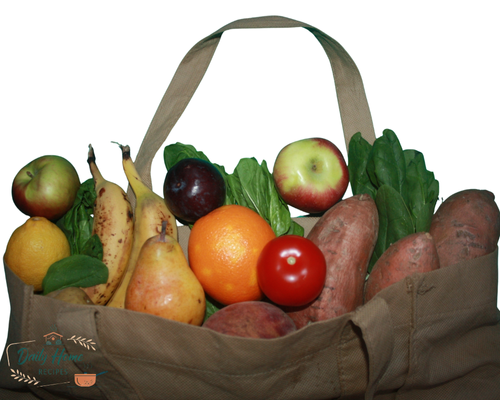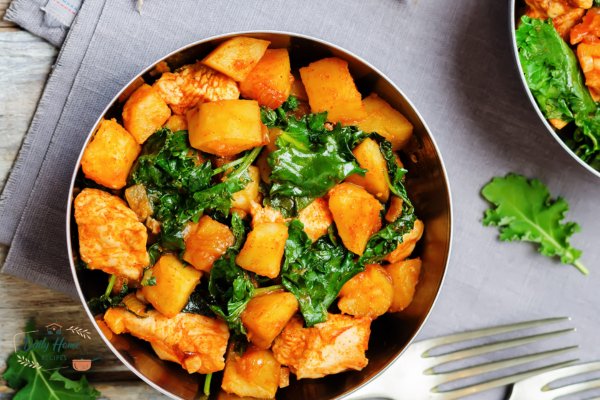There’s this moment usually sometime between 5:17 and 6:03 PM when the thought of dinner hits like a wave. Not because you forgot about it. But because you didn’t and now you have to figure it out. Again.
If that moment feels familiar, this is for you.
A 3-day micro dinner plan isn’t some Pinterest-perfect grid of meals and macros. It’s what happens when you acknowledge that real life doesn’t move in 7-day increments and that sometimes, just planning three dinners ahead is the difference between overwhelm and control.
Think of it as a short-term system for women who are tired of being the default food strategist. You’ll still eat well. You’ll still cook (a little). But you won’t be glued to a calendar or reinventing the wheel nightly.
In this guide, I’ll walk you through:
- What a micro meal plan actually looks like (and why it works for real-life chaos)
- A 3-night dinner strategy that overlaps ingredients without boring your taste buds
- How to turn that plan into a 10-minute grocery dash, not a spreadsheet marathon
- What you can and should reuse between meals (without risking soggy leftovers)
No preachy meal-prep sermons. No rigid schedules. Just relief, simplicity, and a little breathing room.
What’s a 3-Day Micro Plan?
A 3-day micro meal plan is exactly what it sounds like: three dinners, mapped out just far enough to keep the week moving but not so far that you drown in prep. It’s the sweet spot between “I’ll figure it out later” and “Here’s my color-coded meal board with fifteen steps.” Spoiler: you don’t need fifteen steps.
Here’s the deal: traditional 7-day plans often collapse by Wednesday. Life happens plans shift, leftovers pile up, and you end up either tossing food or scrambling for something that fits the day’s chaos. A micro plan trims the fat literally and emotionally.
Why 3 Days Works (And Not 5 or 7)
Let’s break this down. Three dinners mean:
- Less decision fatigue. You don’t have to guess what Wednesday might look like when it’s still Sunday.
- Fewer wasted groceries. No overbuying or rotting herbs hiding in the fridge.
- Built-in flexibility. You can adjust on the fly without the guilt of “ruining the plan.”
Plus, there’s a psychological win here. Committing to just three meals feels doable. It gives you a little confidence hit like, “Okay, I can manage this,” instead of, “Ugh, I have to plan everything.”
Not Meal Prepping. Micro Strategizing.
This isn’t about batch cooking five trays of chicken. It’s about light structure. A rhythm. Enough of a map that you’re not staring into the fridge abyss at 6 PM wondering if salsa and yogurt make a sauce. (Spoiler: they don’t.)
You choose three meals that:
- Share some base ingredients (think: rotisserie chicken, sweet potatoes, chickpeas)
- Shift in flavor or style just enough to stay interesting
- Take 30 minutes or less, or involve zero actual cooking
Is 3 Days Really Enough?
Yes and surprisingly, it’s more than enough for most of us. You’re not locking down your week. You’re just lowering the stakes. Three dinners gives you space to breathe, pivot, and still feed yourself (and your people) like a pro.
What’s a 3-Day Micro Plan?
(No dashes, no bullet points, just smooth flow and depth.)
A 3-day micro meal plan is what you turn to when you’re tired of pretending you have the bandwidth for a full week of dinner decisions. It’s not lazy it’s honest. You plan just enough to stay ahead of the “what’s for dinner?” dread, but not so much that you feel boxed into a system you’ll probably abandon by midweek.
If you’ve ever started a Sunday with a Pinterest tab full of recipes and ended it ordering pizza by Thursday… yeah This is your exit ramp from that cycle.
The idea is simple: three dinners. That’s it. Not because you can’t plan more, but because you shouldn’t have to. Most people overplan. They overbuy. They overthink. And then Thursday rolls around and those wilted herbs in the back of the fridge mock your best intentions. A 3-day micro plan avoids that. It respects your mental load. It gives you structure just short of burnout.
What makes three the magic number? It gives you momentum without commitment. Enough meals to avoid daily panic, but not so many that life can’t throw a wrench into things. Let’s face it: a full 7-day plan assumes nothing will go wrong no surprise takeout, no random leftovers, no last-minute “I’m not in the mood for that” revolt. A micro plan builds in the flexibility to adjust without guilt.
This isn’t meal prepping, by the way. It’s not cooking four pounds of chicken and freezing it into oblivion. It’s strategic not rigid. You choose meals that share a few ingredients, sure, but each one stands on its own. Dinner doesn’t have to be a production, but it also doesn’t have to be sad. Think of it like rhythm, not routine. Like breathing room, not another checklist.
And if you’re wondering, “But is three meals really enough?” the truth is, it’s probably more than you need. Because odds are, one night you’ll eat leftovers. One night, someone won’t be home. One night, cereal might win. This plan doesn’t fight that. It flows with it.
You’re not planning for perfection. You’re just giving yourself a head start.
Sample 3-Day Dinner Layout
Let’s be real most of us aren’t avoiding dinner because we don’t care. We’re avoiding it because it keeps asking for things we don’t have. Time. Energy. Another idea. So when you hear “plan three meals,” your brain might still go, “Ugh, that’s planning.” But this isn’t that kind of plan.

It’s more like dinner drift. You start in one place, and just let the food take you somewhere else.
Night one is simple. You roast some sweet potatoes not because you love sweet potatoes but because they’re forgiving. You can overcook them, under-season them, and they still work. You throw some chicken thighs on the same tray because you’re already there, might as well. Maybe a salad if you’ve got the mental capacity. Or just sliced cucumber. No judgment.
Next night, you’re not cooking from scratch. You’re recomposing. That chicken? Slice it. Those potatoes? Cube them. Dump it all on some rice or farro or whatever you’ve got stashed in the pantry. If you’ve got feta or a scoop of hummus, great. If not, olive oil and lemon still counts. The point isn’t the ingredients. It’s the ease.
By the third night, you’re not even thinking about it. You warm up whatever’s left in a skillet, hit it with a little lime or vinegar or something bright, and wrap it in a tortilla. Or lettuce. Or eat it straight out of the pan because it’s Wednesday and you’re over it.
It’s not meal prep. It’s momentum.
And somewhere in that rhythm, you stop asking, “What do I have to make tonight?” and start thinking, “What can I do with what I already have?” That shift? That’s everything.
You’re not locked into recipes. You’re not trying to win Instagram. You’re just feeding yourself with less friction. And somehow, it tastes better when it didn’t take your entire evening to get there
How to Grocery Shop in 10 Minutes
Let’s not pretend grocery shopping is just about groceries. It’s also the mental gymnastics of trying to remember what’s already in your fridge, what your kids will actually eat, and whether buying that “just in case” bag of arugula will end in guilt or compost.

That’s why the 3-day micro plan isn’t just about meals. It’s about reclaiming time before dinner even starts starting with the store.
If you’ve ever wandered the aisles with a half-formed recipe in your head and no idea if you already have cumin at home… you’re not alone. The 10-minute grocery list is the antidote to that mental clutter. It’s not perfect. But it’s enough
Here’s how it happens
You start with your three dinners nothing fancy, just real ideas. Think: chicken and roasted sweet potatoes, a grain bowl, tacos. Then instead of writing out ingredients per meal like a recipe, you flip the process. Group things by category produce, fridge, pantry, protein because that’s how you move through the store.
You’re not walking in thinking “Do I need garlic?” You’re walking in thinking “I only need five things from produce. I’ll survive this.”
And here’s the quiet magic: by the third time you do this, you start to recognize patterns. You know your go-to proteins, your safe veggies, the sauce that works on everything. You start skipping entire aisles. You shop with rhythm, not with a list that changes every week.
Also ten minutes is generous. If you’re willing to skip the extras, it’s more like six. You’re not planning a Thanksgiving feast. You’re grabbing real stuff for real life. And you’ll be in and out before a podcast episode even ends.
It doesn’t make you a better person. It just makes the rest of your day a little easier. And some days, that’s everything.
FAQ: Can I Reuse Ingredients Across Nights?
Yes. And honestly? You probably already are you just haven’t called it that.
Reusing ingredients across a few nights isn’t lazy, and it doesn’t mean you’re eating leftovers in shame. It’s smart. It’s how people with full lives keep dinner doable. It’s how you stop tossing out half a bunch of cilantro every week.
But here’s the thing: it only works when the meals aren’t carbon copies. You’re not serving the same plate three times. You’re letting your ingredients shape-shift a little. What was roasted sweet potato last night might show up in a grain bowl today. The chicken from Monday ends up in tacos on Wednesday, maybe with lime and a whole new vibe.
You’re not repeating. You’re riffing.
Of course, there’s the storage reality too. Cooked food doesn’t last forever, and the fridge isn’t magic. Airtight containers are non-negotiable. Keep things like proteins and cooked grains visible, labeled if you need to. And if it smells off? Trust your gut and toss it. No plan is worth food poisoning
But when you do it right when you give yourself permission to reuse without guilt it becomes less about “leftovers” and more about momentum. A little lemon here, some cumin there, and suddenly last night’s dinner has new energy. And you didn’t have to start from zero.
That’s the quiet win of a micro meal plan. It doesn’t just save time it saves you from the daily pressure of reinvention.
You don’t need another meal planning system. You need breathing room. A little space between all the “shoulds” and the realities of your life. That’s what a 3-day dinner plan gives you. Not control in the rigid sense, but rhythm. Enough of a map to avoid stress, without boxing you into a version of yourself that has endless time or patience.
It’s not about being the kind of person who plans every detail. It’s about being the kind of person who knows her limits and works with them, not against them.
You’re still feeding your family. Still cooking real meals. You’re just doing it without the pressure to perform every night like it’s a cooking show. And honestly? That’s more than enough.
Start with three dinners. Let them unfold into each other. Grocery shop in minutes, not hours. Use what you already have. And when something goes off-plan which it will you’ll still be okay. Because you didn’t build your week around perfection. You built it around real life.


Leave a Reply